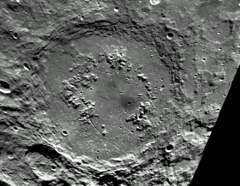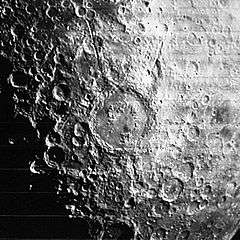Schrödinger (crater)
Schrödinger is a large lunar impact crater of the form traditionally called a walled plain and is named after Erwin Schrödinger. It is located near the south lunar pole on the far side of the Moon, and can only be viewed from orbit. The smaller crater Ganswindt is attached to the southwestern rim of Schrödinger, and intrudes slightly into the inner wall. Adjacent to the south is the crater Nefed'ev. Farther to the southwest is the crater Amundsen.
 Schrödinger from Clementine spacecraft. Note the incomplete inner ring. NASA photo. | |
| Coordinates | 75.0°S 132.4°E |
|---|---|
| Diameter | 312 km |
| Depth | Unknown |
| Colongitude | 245° at sunrise |
| Eponym | Erwin Schrödinger |

Schrödinger possesses a wide outer rim that has been slightly rounded due to subsequent impacts. But the rim remains well-defined, and traces of terraces can be seen along the inner surface. The ejecta on the exterior forms an irregular outer rampart that extends for up to 100 kilometers.
The Schrödinger impact basin is one of a few locations on the Moon that show evidence of geologically recent volcanic activity. A geological study of the basin shows evidence of lava flows and eruptions from vents. There is also older volcanic material and material scattered because of impacts.[1]
Within the interior is a second ring approximately half the diameter of the outer rim. This forms a circular range of rugged mountains that surrounds the center, with the exception of a wide gap in the south. The remainder of the floor has been resurfaced by subsequent lava flows, producing a relatively flat surface particularly within the inner ring. The exception is an area of rough ground in the southeast part of the interior.
A complex of rilles has formed across the floor, forming multiple clefts particularly in the south. The floor has also been marked by subsequent impacts, leaving tiny craterlets scattered across the surface. There is no central peak at the midpoint of the interior.

There is a long, narrow valley leading directly away from Schrödinger to the northwest, designated Vallis Schrödinger. This formation begins some distance from the outer rim of the crater, at the edge of the ejecta that surrounds the perimeter. It extends to the rim of the crater Moulton. Another similar valley designated Vallis Planck radiates to the north, beginning near the crater Grotrian at the periphery of the Schrödinger ejecta, and extending past Fechner.
Satellite craters
By convention these features are identified on lunar maps by placing the letter on the side of the crater midpoint that is closest to Schrödinger.
| Schrödinger | Latitude | Longitude | Diameter |
|---|---|---|---|
| B | 68.4° S | 141.3° E | 25 km |
| G | 75.4° S | 137.2° E | 8 km |
| J | 78.4° S | 154.6° E | 16 km |
| W | 68.5° S | 115.6° E | 12 km |
Popular culture
Schrödinger's Crater is the location of the Moon Nazi base, Schwarze Sonne, in the Finnish film Iron Sky.
References
- Andersson, L. E.; Whitaker, E. A. (1982). NASA Catalogue of Lunar Nomenclature. NASA RP-1097.CS1 maint: ref=harv (link)
- Blue, Jennifer (July 25, 2007). "Gazetteer of Planetary Nomenclature". USGS. Retrieved 2007-08-05.CS1 maint: ref=harv (link)
- Bussey, B.; Spudis, P. (2004). The Clementine Atlas of the Moon. New York: Cambridge University Press. ISBN 978-0-521-81528-4.CS1 maint: ref=harv (link)
- Cocks, Elijah E.; Cocks, Josiah C. (1995). Who's Who on the Moon: A Biographical Dictionary of Lunar Nomenclature. Tudor Publishers. ISBN 978-0-936389-27-1.CS1 maint: ref=harv (link)
- McDowell, Jonathan (July 15, 2007). "Lunar Nomenclature". Jonathan's Space Report. Retrieved 2007-10-24.CS1 maint: ref=harv (link)
- Menzel, D. H.; Minnaert, M.; Levin, B.; Dollfus, A.; Bell, B. (1971). "Report on Lunar Nomenclature by the Working Group of Commission 17 of the IAU". Space Science Reviews. 12 (2): 136–186. Bibcode:1971SSRv...12..136M. doi:10.1007/BF00171763.CS1 maint: ref=harv (link)
- Moore, Patrick (2001). On the Moon. Sterling Publishing Co. ISBN 978-0-304-35469-6.CS1 maint: ref=harv (link)
- Price, Fred W. (1988). The Moon Observer's Handbook. Cambridge University Press. ISBN 978-0-521-33500-3.CS1 maint: ref=harv (link)
- Rükl, Antonín (1990). Atlas of the Moon. Kalmbach Books. ISBN 978-0-913135-17-4.CS1 maint: ref=harv (link)
- Webb, Rev. T. W. (1962). Celestial Objects for Common Telescopes (6th revised ed.). Dover. ISBN 978-0-486-20917-3.CS1 maint: ref=harv (link)
- Whitaker, Ewen A. (1999). Mapping and Naming the Moon. Cambridge University Press. ISBN 978-0-521-62248-6.CS1 maint: ref=harv (link)
- Wlasuk, Peter T. (2000). Observing the Moon. Springer. ISBN 978-1-85233-193-1.CS1 maint: ref=harv (link)
- Zubritsky, Elizabeth (August 30, 2010). "The Moon puts on camo". PhysOrg.com. Retrieved 2010-08-31.
_2.png)